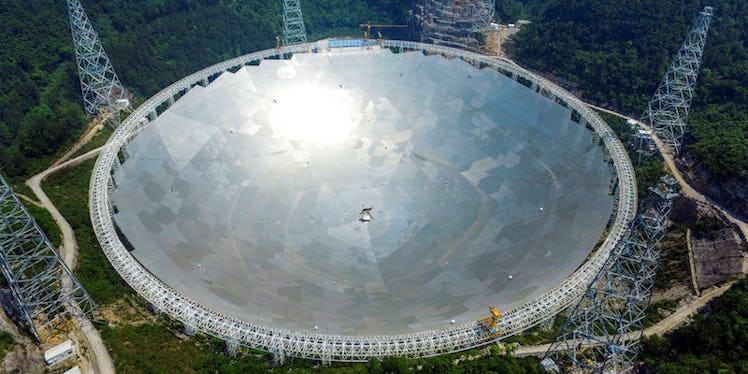
This Chinese Telescope Is Now Officially Our Best Chance At Finding Aliens
Aliens: We gon' find you.
Peurto Rico has officially handed the baton to China after those awesome nerds powered up the world's biggest ET-hunting telescope.
It's called the "Five-hundred-meter Aperture Spherical Telescope" (FAST). Catchy. Yesterday was its first day in action. So far, no aliens have been found. But give it time. I mean, it definitely looks the part.
The hulking dish in Pingtang County, China's southwestern province of Guizhou, is the size of 30 soccer fields and has 4,450 panels. It dwarfs anything the United States has.
Zheng Xiaonian, deputy head of the National Astronomical Observation (NAO) under the Chinese Academy of Sciences, said the telescope will be the global leader for the next couple of decades in searching for UFOs.
The project began back in 2011 and has cost around $180 million with 300 "builders, experts, science fiction enthusiasts and reporters" witnessing the installation. Some 9,000 local people were also displaced from their homes to make room for the telescope.
Nan Rendong, the project's chief scientist, said,
As the world's largest single aperture telescope located at an extremely radio-quiet site, its scientific impact on astronomy will be extraordinary and it will certainly revolutionize other areas of the natural sciences.
That's some pretty big chat from Nan. I hope he backs it up by actually finding life out there. Pressure's on, champ.
Is there alien life out there?
Back in August, astronomers came across a "strong signal" from a distant planet.
Experts believe HD 164595, located 94 light-years away from Earth, is a prime target in the search for extraterrestrial intelligence.
It was originally discovered by a Russian telescope.
They say the signal is so strong, they believe it may be the result of an alien civilization.
Astronomer Douglas Vakoch, president of METI International, told CNN,
The signal from HD 164595 is intriguing, because it comes from the vicinity of a sun-like star, and if it's artificial, its strength is great enough that it was clearly made by a civilization with capabilities beyond those of humankind.
Citations: National Astronomical Observatories